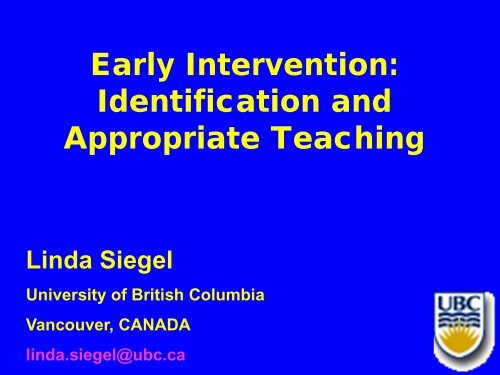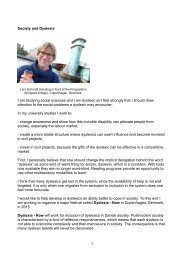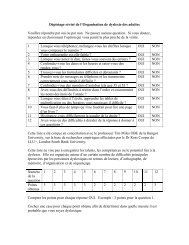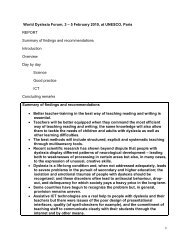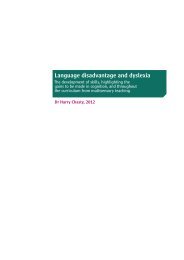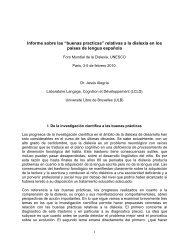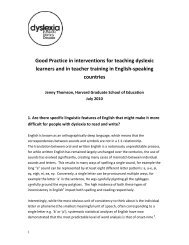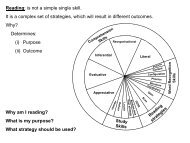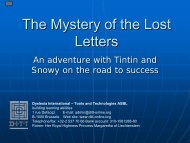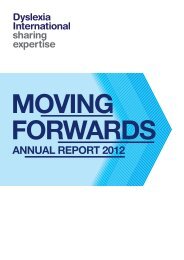Professor Linda Siegel - Dyslexia International
Professor Linda Siegel - Dyslexia International
Professor Linda Siegel - Dyslexia International
- No tags were found...
You also want an ePaper? Increase the reach of your titles
YUMPU automatically turns print PDFs into web optimized ePapers that Google loves.
Early Intervention:Identification andAppropriate Teaching<strong>Linda</strong> <strong>Siegel</strong>University of British ColumbiaVancouver, CANADAlinda.siegel@ubc.ca
Why Early Identification+ Intervention• 82 % of the street youth in Torontohad undetected and unremediatedlearning disabilities• All the adolescent suicides in a 3year period in Ontario hadundetected and unremediatedlearning disabilities
Why Early Identification+ Intervention• 75%-95% of individuals in prisonhave significant reading difficulties• Many minority language studentsfail to complete secondary school.• Undiagnosed and unremediatedreading problems result inemotional and social difficulties
Canadian EducationalPolicies• Inclusion – Language minority chldren• Bilingualism• Multiculturalism – Heritage Languagemaintenance• Children start school at age 5 inkindergarten• Very few private schools -99% ofchildren attend government schools
Aims of the Study• Identify children at risk forliteracy difficulties• Provide an appropriateintervention• Assess the effectiveness of theintervention
Longitudinal Study• Screening at age 5 whenchildren enter school• Tested every year onreading, spelling, arithmetic,language and memory skills• Results at grade 7 – age 13
Longitudinal Sample• All the children in the NorthVancouver School District• 30 schools• Varying SES levels• 20% English Language Learners(ESL)
LANGUAGES IN THE STUDY• Arabic• Armenian• Bulgarian• Cantonese• Croatian• Czech• Dutch• Farsi•German•Greek•Hindi•Hungarian•Indonesian•Italian•Finnish• Japanese• Korean• Kurdish• Mandarin• Norwegian• Polish• Punjabi• Romanian•Russian•Serbian•Slovak•Spanish•Swedish•Tagalog•Tamil•Turkish
nor m a le sKindergartenL1 EnglishELLAt-riskNot at-riskAt-riskNot at-risk
Grade 7L1 EnglishELLDyslexicNormalDyslexicNormal
The children in the studyimproved very significantlyafter good reading instruction.The percentage of dyslexicsdecreased to a small number.
Screening• Effective• Brief – 15-20 minutes• Done by teachers, speechpathologists, psychologists• Provide useful information
Letter Identificationc r m k b w os y t a u d qx l g e z n jp h v i f
PhonologicalAwareness• Ability to break speech downinto smaller units words syllables phonemes
SYLLABLE IDENTIFICATION
RHYME IDENTIFICATION
PHONEME IDENTIFICATION
ORAL CLOZE
Oral cloze• Jane ____her sister went up thehill.• Dad ____ Bobby a letter yesterday.
Reading ReadinessScreening Tool• Designed by teachers, speechtherapists, psychologists• Will be available on the web – freeaccess• Available in English, Spanish,Portuguese• Forthcoming Arabic, Cantonese,Turkish
Intervention Programs• Mostly in the classroom – goodclassroom teaching• Firm Foundations- teaches pre-readingand early phonics skills• Reading 44 – teaches readingcomprehension skills
Firm Foundations• Activities and games designed todevelop–Phonological awareness–Letter sound relationships–Vocabulary–Syntactic skills
• Circle Skills -Teaching the whole class• Centre Skills – Practicing in small groups• Assessment - Working with individualstudents
Results at Grade 7
Word Identificationcatseebookshouldfingergluttonemphasisintrigueusurpidiosyncrasy
Word Identification9080706050403020100Normal L1Normal ELLDyslexic L1Dyslexic ELL
Woodcock Word Attackdeepogchedgouchcigbetbafmotbemmonglustamer
Word Attack9080706050403020100Normal L1Normal ELLDyslexic L1Dyslexic ELL
Phoneme/Syllable Deletion20181614121086420Normal L1Normal ELLDyslexic L1Dyslexic ELL
Spelling9080706050403020100Normal L1Normal ELLDyslexic L1Dyslexic ELL
Pseudoword Spelling80706050403020100Normal L1Normal ELLDyslexic L1Dyslexic ELL
Oral Cloze181614121086420Normal L1Normal ELLDyslexic L1Dyslexic ELL
Reading 44• Training readingcomprehension strategies• Vocabulary•Syntax
Stanford ReadingComprehension706050403020Normal L1Normal ELLDyslexic L1Dyslexic ELL100
SES & Reading0.60.50.40.30.20.10K-97 K-98 Grade 1 Grade 2 Grade 3
Conclusions• It is possible to identify children at risk forreading disabilities in kindergarten.• It is possible to provide a classroom basedintervention to bring most of these children toat least average levels of reading.• Children learning English as a secondlanguage can perform at L1 levels andbilingualism may be an advantage.
ConclusionsMost ELL dyslexic children have betterreading, spelling and phonological skillsthan their monolingual peers.Many ELL normal readers have betterEnglish reading, phonological, andspelling skills in their second languagethan children who have English as a firstlanguage.
Caveats• The development of language andliteracy skills in ESL studentsrequires good teaching• First language maintenance isimportant wherever possible
Internet Resourceshttp://www.nvsd44.bc.ca–Click on Firm Foundations–Click on Reading 44


